|
|
|
|
|
Oil On
Canvas, Real Flavor of Old Masters
|
|

|
ARTWORKS
INDEX
A B C D E F G H I J K L M N O P Q R S T U V W X Y Z |
ARTISTS
INDEX
A B C D E F G H I J K L M N O P Q R S T U V W X Y Z |
|
|
| | |
|
|
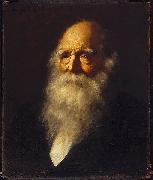 |
Wyatt Eaton -- Click Here
|
|
(May 6, 1849 - June 7, 1896) was an Canadian/American portrait and figure painter, remembered as one of the founders of the Society of American Artists.
Born in Philipsburg, Quebec, Lower Canada, Eaton was a student of the National Academy of Design, New York. In 1872, he moved to Paris and studied at the École des Beaux-Arts under Jean-Leon Gerôme. During this time, he made the acquaintance of Jean-François Millet at Barbizon, and was also influenced by his friend Jules Bastien-Lepage.
After his return to the United States in 1877, he became a teacher in the Cooper Institute, and opened a studio in New York City. He became one of the founders of the Society of American Artists, in which he was the first secretary. Eaton died from tuberculosis at Newport, Rhode Island on June 7, 1896.
|
|
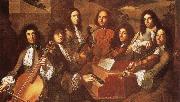 |
william wordsworth -- Click Here
|
|
Born: 7 April 1770
Birthplace: Cockermouth, England
Died: 23 April 1850
Best Known As: The author of the poem "Tintern Abbey"
|
|
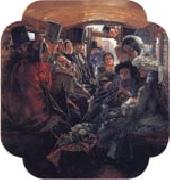 |
William Maw Egley -- Click Here
|
|
English painter , (1826-1916)
was a British artist of the Victorian era. The son of the miniaturist William Egley, he studied under his father. His early works were illustrations of literary subjects typical of the period, such as Prospero and Miranda from The Tempest. These were similar to the work of The Clique. William Powell Frith, one of The Clique, hired Egley to add backgrounds to his own work. Egley soon developed a style influenced by Frith, including domestic and childhood subjects. Most of his paintings were humorous or "feelgood" genre scenes of urban and rural life, depicting such subjects as harvest festivals and contemporary fashions. His best known painting, Omnibus Life in London (Tate Gallery) is a comic scene of people squashed together in the busy, cramped public transport of the era. Egley always showed great interest in specifics of costume, to which he paid detailed attention, but his paintings were often criticised for their hard, clumsy style. In the 1860s Egley adopted the fashion for romanticised 18th century subjects. |
|
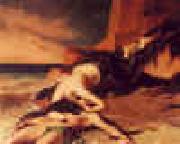 |
William Etty -- Click Here
|
|
1787-1849
English
William Etty Location
English painter. Born into a Methodist family, he was the seventh child of a miller and baker in Feasegate, York, and in 1798 he was apprenticed as a printer to Robert Peck, publisher of the Hull Packet. Financial support from his uncle, a banker, allowed him to go to London in 1805, where he entered the Royal Academy Schools in 1806. For a year, in 1807-8, he was a pupil of Thomas Lawrence, who greatly influenced him. Following the death of his uncle in 1809 he became financially secure. From 1811 he exhibited regularly at the Royal Academy and the British Institution and in 1816 worked in the studio of Jean-Baptiste Regnault in Paris. |
|
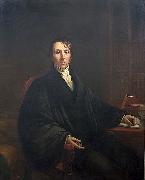 |
William Ellery Channing -- Click Here
|
|
(April 7, 1780 - October 2, 1842) was the foremost Unitarian preacher in the United States in the early nineteenth century and, along with Andrews Norton, one of Unitarianism's leading theologians. He was known for his articulate and impassioned sermons and public speeches, and as a prominent thinker in the liberal theology of the day. |
|
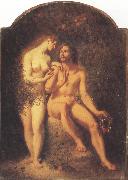 |
William Edward frost R.A. -- Click Here
|
|
1810-1877
was an English painter of the Victorian era. Virtually alone among English artists in the middle Victorian period, he devoted his practice to the portrayal of the female nude. Frost was educated in the schools of the Royal Academy, beginning in 1829; he established a reputation as a portrait painter before branching into historical and mythological subjects, including the sub-genre of fairy painting that was characteristic of Victorian art. In 1839 he won the Royal Academy's gold medal for his "Prometheus Bound," and in 1843 he won a prize in the Westminster Hall competition for his "Una Alarmed by Fauns" (a subject from Spenser's The Faerie Queen). He was elected an associate member of the Royal Academy in 1846, and a full member in 1870. Frost is widely recognized as a follower of William Etty, who preceded him as the primary British painter of nudes in the second quarter of the nineteenth century. |
|
|
|
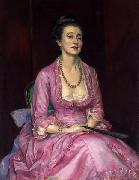 |
William Bruce Ellis Ranken -- Click Here
|
|
United Kingdom (1881- 1941 ) - Watercolours
painted Souvenir of the seventies. Signed with monogram and dated 1923 |
|
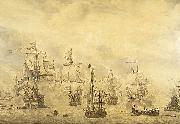 |
Willem van de Velde the Elder -- Click Here
|
|
(c. 1611 - 13 December 1693) was a Dutch Golden Age seascape painter.
Willem van de Velde, known as the Elder, a marine draughtsman and painter, was born in Leiden, the son of a Flemish skipper, Willem Willemsz. van de Velde, and is commonly said to have been bred to the sea. In 1706 Bainbrigg Buckeridge noted that he eunderstood navigation very welle. He married Judith Adriaensdochter van Leeuwen in Leiden, the Netherlands, in 1631.
His three known legitimate children were named Magdalena, born 1632; Willem, known as the Younger, also a marine painter, born 1633; and Adriaen, a landscape painter, born 1636.
His marriage was stormy, at least in its later years. David Cordingly relates that Willem the Elder fathered two children out of wedlock in 1653, one eby his maidservant, and the other by her friend. Nine years later the Elder and his wife went through a legal separation, eon account of legal disputes and the most violent quarrelse. The immediate cause of the dispute was his affair with a married woman.e Michael S. Robinson noted that eon 17/27 July 1662, he and his wife agreed to part. A condition of the separation was that the Elder could recover from his son Adriaen etwo royal giftse, presumably gifts from Charles II for work done in England.e Cordinglyes account further relates that the dispute was still continuing after another ten years, since ein the autumn of 1672 Judith complained to the womanes husband.e Robinson adds that by 1674 the couple emust have been reconcilede, for at a chance meeting with Pieter Blaeu in Amsterdam in July the Elder explained that he was only visiting for a few days ein order to fetch his wifee. His son, Adriaen, had died in Amsterdam in 1672, and Willem the Elder was also fetching his grandson, similarly named Adriaen, who was then aged two.
After his move to England, the exact date of which is uncertain, but reportedly at the end of 1672 or beginning of 1673, he is said to have lived with his family in East Lane, Greenwich, and to have used the Queenes House, now part of the National Maritime Museum in Greenwich, as a studio. Following the accession of William and Mary as King and Queen of England, it appears that this facility was no longer provided, and by 1691 he was living in Sackville Street, now close to Piccadilly Circus. He died in London, and was buried in St Jameses Church, at the south end of the street.
|
|
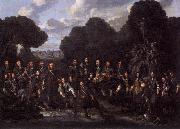 |
Willem Eversdijck -- Click Here
|
|
the son of Cornelis Eversdijck, flourished at Goes about the year 1660. He was a portrait painter, and several of his portraits were engraved by Houbraken. A picture of Officers and Members of the Company of Archers, called " Edele Voetboog," at Goes, by him, is in the Rotterdam Museum.
Cornelis Willemsz Eversdijck, his father, was also a portrait painter of Goes, who died there in 1649. In the Rotterdam Museum are three pictures by him, representing Officers and Members of the Company of Archers, called "Edele Voetboog," at Goes; two of which are dated 1616 and 1624.
|
|
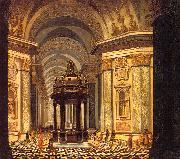 |
Wilhelm Schubert van Ehrenberg -- Click Here
|
|
1630-1676
Flemish
Wilhelm Schubert van Ehrenberg Location |
|
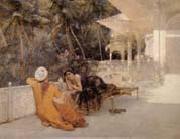 |
Weeks Lord-Edwin -- Click Here
|
|
189-1903
American artist, was born at Boston, Massachusetts, in 1849. He was a pupil of Leon Bonnat and of Jean-Leon Gerome, at Paris. He made many voyages to the East, and was distinguished as a painter of oriental scenes. In 1895 he wrote and illustrated a book of travels, From the Black Sea through Persia and India, and two years later he published Episodes of Mountaineering. He died in November 1903. He was a member of the Legion d'honneur, France, an officer of the Order of St. Michael, Germany, and a member of the Secession, Munich. |
|
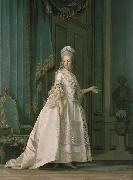 |
Vigilius Eriksen -- Click Here
|
|
(b Copenhagen, 2 Sept 1722; d Copenhagen, 23 or 24 May 1783). Danish painter, active also in Russia. He was apprenticed to the portrait painter Johann Salomon Wahl in Copenhagen. In 1755 he competed unsuccessfully for the gold medal at the Royal Academy of Art in Copenhagen with a historical painting, Lot and his Wife (untraced). In a letter he complained that the rules did not allow him to enter a portrait, a genre more suited to his talents. Presumably in 1756 he completed the portraits of the registrar of the royal art collections, Lorenz Spengler and his Wife (Copenhagen, Stat. Mus. Kst). |
|
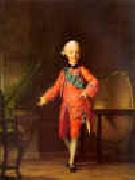 |
Vigilius Erichsen -- Click Here
|
|
1772-1782
Danish
Vigilius Erichsen Location |
|
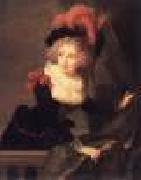 |
VIGEE-LEBRUN, Elisabeth -- Click Here
|
|
French painter (full name: Marie-Louise-Élisabeth Vigee-Lebrun). Vigee LeBrun's most famous client was Marie Antoinette, France's much maligned queen. When the two met in 1778, Vigee LeBrun's art-dealer husband had gambled away his wife's earnings. Still, she was dauntless and set out to establish her own salon where she would court royal clients. In a November 1982 article for Art in America, Brooks Adams noted that in her memoirs, Vigee LeBrun said that her much sought-after salon was, "a place where art and society mixed, where noblemen and ministers were content to sit on the floor, to avoid the stiff, formal court entertainments at Versailles." In time, her portraits and memoirs alike painted a portrait of Vigee LeBrun as a woman born to contend with anyone. Unfortunate Circumstances Marie Louise Elisabeth Vigee LeBrun was born in 1755 in Paris. Her father was Louis Vigee, a little-known portrait artist who worked in pastels. From the time she was small, he taught his daughter the skills of the trade. She proved to be somewhat of a prodigy. Her parents placed Vigee LeBrun in the convent of La Trinite, directly behind the Bastille. Her earliest memories were of drawing so frantically on the walls of her dormitory that the sisters regularly punished her. When her father died, Vigee LeBrun was only 12. He had been her biggest supporter. For an article in Antiques, magazine in November 1967, Ilse Bischoff quoted Vigee LeBrun's father after he saw a drawing she had done as a small child. It was the head of a bearded man with the light of a lamp falling on his face. She took care to observe light and shade, and showed skill beyond her years. Her father had exclaimed, "You will be a painter if I ever saw one." By the time she was 15, Vigee LeBrun had established a business as a painter that provided major financial support for her family. Her mother was a hairdresser from Luxembourg, who remarried not long after her first husband's death. Her stepfather soon began to squander her earnings. When she was only 21, she married an art dealer named Pierre LeBrun. It was clearly a marriage more of convenience, than of love. They had one daughter, Julie, born in 1780. Vigee LeBrun's marriage helped her gain access to a world normally restricted to men. Although she was denied access to a male apprentice system, and was unable to participate in classes at the major art academies around the city, she gained admission to the lesser salon of the Academie de Saint Luc. However, the Academie Royale was closed to her without proper connections. In those days, being shown in lesser salons kept a painter away from the financial benefits to be gained from wealthier clients who frequented the prestigious Academie Royale. When Vigee LeBrun was finally admitted to the Royale in 1783, her critics were not kind. She was accused of using her husband and the palace, most particularly her friendship with Queen Marie Antoinette. Another unfortunate rumor was that she had a long-standing sexual affair with the finance minister, Calonne. Her accusers contended that he aided her in squandering much of the Royal Treasury. That was never proven. Still, it was clear that she capitalized on her associations with the queen and the rest of the royal family. The aristocracy longed to be seen as simple, especially as unrest grew among the people outside of the palace confines. One portrait of Marie Antoinette was considered so scandalously informal, that it was withdrawn from the salon in the midst of her debut at the Academie Royale. Vigee LeBrun's arch-rival was a woman painter named Madame Labille Guiard. They were admitted to the Academie Royale on the same day. For the rest of the decade, before the French Revolution erupted in 1789, the two women maintained their rivalry. At the time of the academy's biennial exhibitions, the bitterness they felt toward each other had reached the height of its intensity. Vigee LeBrun painted one of her most acclaimed works in 1784. It was the portrait of Marie-Gabrielle de Gramont, Duchess of Caderousse. That was the same year she suffered a miscarriage, and painted only five portraits. Her usual output far exceeded that. The portrait was shown at the Salon of 1785 to much acclaim and became one of the artist's most celebrated works. In her memoirs, written fifty years later, Vigee LeBrun recalled the painting. "As I detested the female style of dress then in fashion, I bent all my efforts upon rendering it a little more picturesque, and was delighted when, after getting the confidence of my models, I was able to drape them according to my fancy. Shawls were not yet worn, but I made an arrangement with broad scarfs lightly intertwined around the body and on the arms, which was an attempt to imitate the beautiful drapings of Raphael and Domenichino I could not endure powder persuaded the Duchess to put none on for her sittings." Thrived in Exile Vigee LeBrun was not immune to the anxious rumbling that became the French Revolution. What had begun on that fateful night of July 14, 1789, erupted further when mobs stormed the palace at Versailles on the following October 6. Vigee LeBrun had been in disfavor for her association with Marie Antoinette for some time and was considered to be a royal sympathizer. |
|
 |
VELDE, Esaias van de -- Click Here
|
|
Dutch painter (b. ca. 1591, Amsterdam, d. 1630, Den Haag).
|
|
|
|
|
|
 |
ulrika eleonora -- Click Here
|
|
Ulrika Eleonora d.y., född 23 januari 1688, död 24 november 1741, var regerande drottning av Sverige 1719-1720, dotter till Karl XI och Ulrika Eleonora av Danmark, syster till Karl XII samt kusin till August den starke, Fredrik IV av Danmark och Fredrik IV av Holstein-Gottorp.
Hon gifte sig 24 mars 1715 med Fredrik av Hessen, den blivande Fredrik I, men förblev barnlös.
Ulrika Eleonora föddes den 23 januari 1688 på Stockholms slott som dotter till kung Karl XI och Ulrika Eleonora d.ä. Under barndomen förbisågs hon av alla för sin äldre, livligare och mera begåvade syster Hedvig Sofia.
Så snart hon blivit giftasvuxen fick hon många friare, bland andra blivande Georg II av Storbritannien och arvprins Fredrik av Hessen-Kassel. Redan 1710 begärde denne hennes hand, men deras trolovning tillkännagavs inte förrän den 23 januari 1714. Bilägret firades den 24 mars 1715.
Under Karl XII:s vistelse utomlands var hon, efter Hedvig Sofias död (1708), den enda myndiga medlemmen av kungahuset inom riket om man borträknar hennes åldriga farmor (Hedvig Eleonora).
I slutet av 1712 eller början av 1713 hade Karl XII tankar om att göra sin syster Ulrika Eleonora till regent, men fullföljde inte denna plan. Det kungliga rådet däremot övertalade henne att bevista dess sammanträden för att i henne erhålla ett stöd. Första gången hon infann sig i rådet, 2 november 1713, beslöts också om sammankallande av en riksdag. Det s.k. rörelsepartiet vid denna riksdag ville att prinsessan i kungens frånvaro skulle göras till riksföreståndarinna "såsom närmaste arvinge till kronan och regementet". Detta förslag motarbetades av Arvid Horn och rådet, som fruktade att svårigheterna för en ändring av regeringssättet därigenom skulle ökas. Prinsessan visade emellertid ständerna stort intresse för landets angelägenheter. I sina brev till kungen uppmanade hon honom att återvända hem och varnade honom för möjliga följder av hans frånvaro. Med hans samtycke undertecknade hon under den följande tiden alla rådets skrivelser, utom dem som var ställda till honom, för i sin egenskap av vice regent var hon ett med kungen enligt dennes uppfattning. Mera sällan deltog hon i rådets förhandlingar. |
|
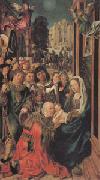 |
Ulrich apt the Elder -- Click Here
|
|
Augsburg 1455/60-1532 |
|
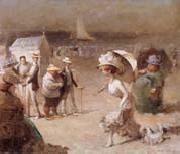 |
Trigoulet Eugene -- Click Here
|
|
French ,1867-Berck-sur-Mer 1910
|
|
|
|
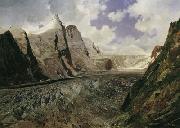 |
Thomas Ender -- Click Here
|
|
(3 November 1793 Vienna - 28 September 1875 Vienna) was an Austrian painter.
He was twin brother of Johann Ender. He also studied at the Vienna Academy, becoming a noted landscape painter. He won the grand prize at the Vienna Academy in 1816. Going to Brazil in 1817, he brought back nearly a thousand drawings and water colors. He visited Italy, Palestine, Greece and Paris. In 1836, he became corrector and later professor at the Vienna Academy, filling that chair until 1849.
|
|
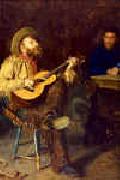 |
Thomas Eakins -- Click Here
|
|
American Realist Painter, 1844-1916.
Thomas Cowperthwait Eakins (July 25, 1844 ?C June 25, 1916) was a realist painter, photographer, sculptor, and fine arts educator. He is widely acknowledged to be one of the most important artists in American art history.
For the length of his professional career, from the early 1870s until his health began to fail some forty years later, Eakins worked exactingly from life, choosing as his subject the people of his hometown of Philadelphia. He painted several hundred portraits, usually of friends, family members, or prominent people in the arts, sciences, medicine, and clergy. Taken en masse, the portraits offer an overview of the intellectual life of Philadelphia in the late 19th and early 20th centuries; individually, they are incisive depictions of thinking persons. As well, Eakins produced a number of large paintings which brought the portrait out of the drawing room and into the offices, streets, parks, rivers, arenas, and surgical amphitheaters of his city. These active outdoor venues allowed him to paint the subject which most inspired him: the nude or lightly clad figure in motion. In the process he could model the forms of the body in full sunlight, and create images of deep space utilizing his studies in perspective.
No less important in Eakins' life was his work as a teacher. As an instructor he was a highly influential presence in American art. The difficulties which beset him as an artist seeking to paint the portrait and figure realistically were paralleled and even amplified in his career as an educator, where behavioral and sexual scandals truncated his success and damaged his reputation.
Eakins also took a keen interest in the new technologies of motion photography, a field in which he is now seen as an innovator. Eakins was a controversial figure whose work received little by way of official recognition during his lifetime. Since his death, he has been celebrated by American art historians as "the strongest, most profound realist in nineteenth-and early-twentieth-century American art". |
|
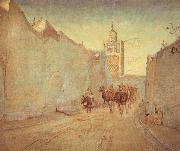 |
Theodor Esbern Philipsen -- Click Here
|
|
1840-1920
Danish painter, sculptor and draughtsman. He studied at the Kongelige Akademi for de Skenne Kunster, Copenhagen, in 1862-3 and 1865-9, and in Paris under Leon Bonnat in 1875-6. He was an important figure in the development and renewal of Danish naturalism, linking the Danish Golden Age tradition with new French ideas. Conscious of the importance of plein-air painting, he was first a great admirer of the Barbizon school; later he was influenced by the Impressionists, becoming the only truly Danish Impressionist. Frequent visits abroad helped him develop his outlook; he eagerly studied the Old Masters, and the strong light of the south
|
|
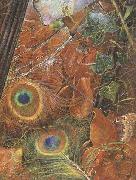 |
The Hon.Eleanor Vere Boyle -- Click Here
|
|
1825-1916
|
|
 |
STEINLE, Edward Jakob von -- Click Here
|
|
Austrian painter
b. 1810, Wien, d. 1886, Frankfurt |
|
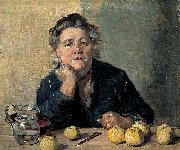 |
St Edmundsbury Borough Council -- Click Here
|
|
painted Rose Mead; Barbara Stone in1940 |
|
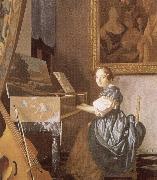 |
solomon eccles -- Click Here
|
|
also known as Solomon Eagle (1618 - 1683) was an English composer.
Little if any of his works are extant since, when he became a Quaker, he burned all his books and compositions so as to distance himself from church music. His repugnance for the organised church showed in his name for them: "steeple-houses".
|
|
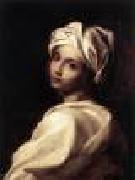 |
SIRANI, Elisabetta -- Click Here
|
|
Italian Baroque Era Painter, 1638-1665
Italian painter. She was the daughter of Giovanni Andrea Sirani (1610-70), who had been Guido Reni's principal assistant. Encouraged by Carlo Malvasia, her mentor and eventual biographer, she was painting professionally by the age of 17. Her prolific talent, as well as her reputed beauty and modesty, soon brought her European renown. The details of her training are unclear, but as a woman she would not have had access to an academy and (like many other professional women painters prior to the 20th century) she was probably taught by her father. Her sisters Anna Maria (1645-1715) and Barbara (alive in 1678) were also practising artists and Elisabetta herself is known to have had female students. As women, they could not undertake any formal study of the male nude, and Sirani's weakness in depicting male anatomy is sometimes clearly detectable in her work Sirani's drawings employ a highly individual pen-and-wash method, eschewing outline and employing quick, blunt strokes of barely dilute ink to create striking chiaroscuro effects |
|
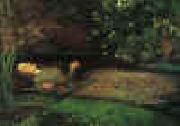 |
Sir John Everett Millais -- Click Here
|
|
British 1829-1896 Sir John Everett Millais Galleries After his marriage, Millais began to paint in a broader style, which was condemned by Ruskin as "a catastrophe". It has been argued that this change of style resulted from Millais' need to increase his output to support his growing family. Unsympathetic critics such as William Morris accused him of "selling out" to achieve popularity and wealth. His admirers, in contrast, pointed to the artist's connections with Whistler and Albert Moore, and influence on John Singer Sargent. Millais himself argued that as he grew more confident as an artist, he could paint with greater boldness. In his article "Thoughts on our art of Today" (1888) he recommended Vel??zquez and Rembrandt as models for artists to follow. The Two Princes Edward and Richard in the Tower (1878) The Boyhood of Raleigh (1871)Paintings such as The Eve of St. Agnes and The Somnambulist clearly show an ongoing dialogue between the artist and Whistler, whose work Millais strongly supported. Other paintings of the late 1850s and 1860s can be interpreted as anticipating aspects of the Aesthetic Movement. Many deploy broad blocks of harmoniously arranged colour and are symbolic rather than narratival. Later works, from the 1870s onwards demonstrate Millais' reverence for old masters such as Joshua Reynolds and Vel??zquez. Many of these paintings were of an historical theme and were further examples of Millais' talent. Notable among these are The Two Princes Edward and Richard in the Tower (1878) depicting the Princes in the Tower, The Northwest Passage (1874) and the Boyhood of Raleigh (1871). Such paintings indicate Millais' interest in subjects connected to Britain's history and expanding empire. His last project was to be a painting depicting a white hunter lying dead in the African veldt, his body contemplated by two indifferent Africans. This fascination with wild and bleak locations is also evident in his many landscape paintings of this period, which usually depict difficult or dangerous terrain. The first of these, Chill October (1870) was painted in Perth, near his wife's family home. Many others were painted elsewhere in Perthshire, near Dunkeld and Birnam, where Millais rented grand houses each autumn in order to hunt and fish. Millais also achieved great popularity with his paintings of children, notably Bubbles (1886) ?C famous, or perhaps notorious, for being used in the advertising of Pears soap ?C and Cherry Ripe. |
|
|
|
sir herbert edwin pelham hughes-stanton,r.a.,p.r.w.s. -- Click Here
|
|
1870-1937 |
|
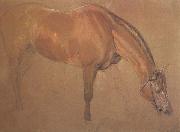 |
Sir edwin landseer,ra -- Click Here
|
|
1802-1873
Painter, draughtsman, sculptor and etcher, brother of (3) Charles Landseer. He became the best-known member of the family and was one of the most highly respected and popular British painters of the 19th century. He was first trained by his father, who taught him etching, and he then studied with Benjamin Robert Haydon and at the Royal Academy Schools in London. Precociously gifted, he drew competently from childhood and in 1813 he won the Silver Palette for draughtsmanship at the Society of Arts. In 1815 he exhibited at the Royal Academy for the first time, showing some drawings of a mule and of the heads of dogs. From an early age he was a frequent visitor to the menagerie in Exeter Change in the Strand, London, where he drew lions, monkeys and other animals. |
|
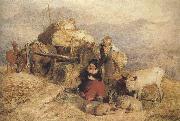 |
Sir edwin henry landseer,R.A. -- Click Here
|
|
1802-1873
Painter, draughtsman, sculptor and etcher, brother of (3) Charles Landseer. He became the best-known member of the family and was one of the most highly respected and popular British painters of the 19th century. He was first trained by his father, who taught him etching, and he then studied with Benjamin Robert Haydon and at the Royal Academy Schools in London. Precociously gifted, he drew competently from childhood and in 1813 he won the Silver Palette for draughtsmanship at the Society of Arts. In 1815 he exhibited at the Royal Academy for the first time, showing some drawings of a mule and of the heads of dogs. From an early age he was a frequent visitor to the menagerie in Exeter Change in the Strand, London, |
|
 |
Sir Edward john poynter,bt.,P.R.A -- Click Here
|
|
1836-1919
English painter, draughtsman, decorative designer and museum official. He came from an artistic family: his great-grandfather was Thomas Banks the sculptor, and Ambrose Poynter, his father, was an architect and watercolour painter. Edward began studying art in 1852 under Thomas Shotter Boys, a friend of his father. In 1853-4 Poynter visited Rome, where he was greatly impressed by the large-scale academic painting of Frederic Leighton. Returning to London, he studied at Leigh's Academy and the studio of William Dobson (1817-1898). Poynter entered the Royal Academy Schools in 1855 but his admiration for French painting led him to Charles Gleyre's studio in Paris the following year. He remained there until 1859, with fellow students George Du Maurier, Thomas Armstrong and Whistler; their activities are described in Du Maurier's novel Trilby (1894). At this time Poynter received his first commissions for decorative work. He began designing stained glass and painting furniture and, after his return to England, he was employed by his friend the architect William Burges to decorate the ceiling of Waltham Abbey, Essex, in 1860. |
|
 |
Sir Edward john Poynter,Bart.PRA,RWS -- Click Here
|
|
1836-1919
|
|
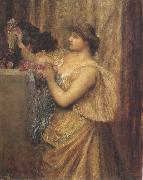 |
Sir edward coley burne-jones,Bt.,A.R.A.,R.W.S -- Click Here
|
|
1833-1898
English painter and decorative artist. He was the leading figure in the second phase of the Pre-Raphaelite movement. His paintings of subjects from medieval legend and Classical mythology and his designs for stained glass, tapestry and many other media played an important part in the Aesthetic Movement and the history of international Symbolism. |
|
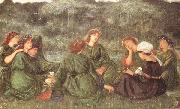 |
Sir Edward Coley Burne-jones,Bart.,ARA,RWS -- Click Here
|
|
1833-1898
|
|
 |
Sir Edward Coley Burne-Jones -- Click Here
|
|
British Pre-Raphaelite Painter, 1833-1898
English painter and decorative artist. He was the leading figure in the second phase of the Pre-Raphaelite movement. His paintings of subjects from medieval legend and Classical mythology and his designs for stained glass, tapestry and many other media played an important part in the Aesthetic Movement and the history of international Symbolism. |
|
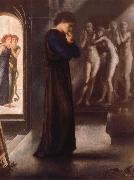 |
Sir Edward Burne-Jones -- Click Here
|
|
Britain 1833-1898
English painter and decorative artist. He was the leading figure in the second phase of the Pre-Raphaelite movement. His paintings of subjects from medieval legend and Classical mythology and his designs for stained glass, tapestry and many other media played an important part in the Aesthetic Movement and the history of international Symbolism. |
|
|
|
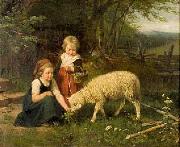 |
Rudolf Epp -- Click Here
|
|
Rudolf Epp , painter (1834-1910) |
|
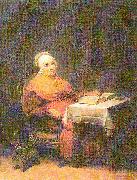 |
Robert Wilhelm Ekman -- Click Here
|
|
(August 13, 1808 - February 19, 1873), aka R. W. Ekman, was a significant teacher and painter of the Finnish romantic portraits and early national romanticism.
Robert Ekman was born in Uusikaupunki, Finland to an upper class family. His father was Karl Kristoffer Ekman, a medical doctor and a mayor. Mother was Sara Elisabet (maiden name Gadolin). Robert Ekman's both parents died when he was about 10 years old. They left behind five orphans who were placed in foster homes. Schooling was incomplete and there was no chance of academic education.
Robert Ekman first studied in Finland under the guidance of Gustaf Wilhelm Finnberg, but in 1824, with his brother Fredrubjm begun studies in Kungliga Akademien för de Fria Konsterna (The royal academy for free arts) in Stockholm. Already as a student Ekman specialized in portraying the life of the common people, instead of Classicism of the academic arts. Ekman graduated in 1836, and was granted a generous traveling scholarship for excelling in his studies. That supported him working in Holland, France and Italy between years 1837-1844. As the scholarship was not plausible otherwise, Ekman took the Swedish citizenship.
|
|
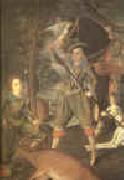 |
Robert Peake the Elder -- Click Here
|
|
1576-1626
British
Robert Peake Gallery |
|
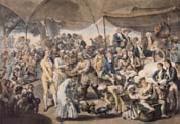 |
Richard Earlom -- Click Here
|
|
English Printmaker, 1743-1822,English printmaker. Taught by Giovanni Battista Cipriani, he worked in mezzotint, etching and occasionally stipple. His mezzotints of flowers and still-lifes, such as Roses for the Temple of Flora (1805) by Robert John Thornton (?1768-1837) or the Fruit Piece (see Wessely, no. 145) after Jan van Huysum, are also found printed in colours or coloured by hand. Earlom's most influential prints were a set of outline etchings combined with mezzotint of the volume, then belonging to the Dukes of Devonshire, of Claude's drawings of his own landscape paintings |
|
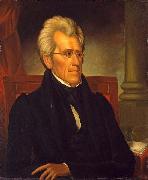 |
Ralph Eleaser Whiteside Earl -- Click Here
|
|
(1785-8 - Nashville, Tennessee, September 16, 1838), also known as Ralph E. W. Earl or Ralph Eleazer Whiteside Earl, was an American painter known as the "court painter" to President Andrew Jackson.
Earl was the son of portrait painter Ralph Earl and his second wife Ann Whiteside. He was born c. 1785-88, probably in New York City, and likely received his early training in portraiture from his father, whose naive style is reflected in the younger Earl's earliest works. He traveled to London in 1809, where he studied for a year with John Trumbull and was advised by Benjamin West, learning perspective, anatomy, and three-dimensional illusion. He remained in England until 1814, living with his maternal grandfather and uncle in Norwich and executing portrait commissions. He then traveled to Paris before returning to the United States in December 1815 with the intention of creating grand-scale history paintings on the European model.
As preparation for a planned project depicting the Battle of New Orleans, Earl met General Andrew Jackson and visited him at his Tennessee home, The Hermitage, in January 1817. Earl painted portraits of Jackson and his family, and married Mrs. Jackson's niece Jane Caffery on 19 May 1819. She died in childbirth in 1820. |
|
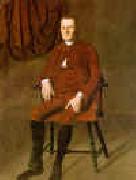 |
Ralph Earl -- Click Here
|
|
1751- 1801
Ralph Earl Galleries
Ralph Earl was born in either Shrewsbury or Leicester, Massachusetts. By 1774, he was working in New Haven, Connecticut as a portrait painter. In the autumn of 1774, Earl returned to Leicester, Massachusetts to marry his cousin, Sarah Gates. A few months later, their daughter was born; however, Earl left them both with Sarah's parents and returned to New Haven.
Like so many of the colonial craftsmen, Earl was self-taught, and for many years was an itinerant painter. In 1775, Earl visited Lexington and Concord, which were the sites of recent battles in the American Revolution. Together with engraver Amos Doolittle, he painted four of his most famous pictures, all battle scenes.
Although his father was a colonel in the Revolutionary army, Ralph Earl himself was a Loyalist. In 1778, he left behind his wife and daughter and escaped to England by disguising himself as the servant of British army captain John Money. |
|
 |
POEL, Egbert van der -- Click Here
|
|
Dutch Baroque Era Painter, 1621-1664 |
|
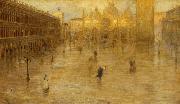 |
Pietro Fragiacomo -- Click Here
|
|
(Pirano deIstria (Trieste), 1856 - Venice, 1922) was an Italian painter.
Born at Pirano deIstria near Trieste, Fragiacomo moved with his family to Venice, where he enrolled at the Academy of Fine Arts in 1878 after a period as a worker in Treviso. He then abandoned his studies barely one year later to devote himself more freely to painting from life, often in the company of his friend the painter Giacomo Favretto. He won a bronze medal at the Universal Exhibition of 1889 in Paris and took part in the Munich International Exhibition of the same year, as well as later editions. Drawing inspiration from the Venetian lagoon and always characterised by a crepuscular sense of nature, his landscapes took on Symbolist overtones at the end of the century. He won the Prince Umberto Prize at the Milan Triennale of 1891 and was a regular participant from 1895 to 1922 at the Venice Biennale, which held a solo show of his work in 1910 and a posthumous retrospective in 1924.
|
|
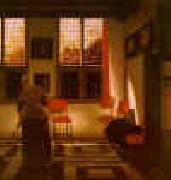 |
Pieter Janssens Elinga -- Click Here
|
|
1623-1682
Dutch
Pieter Janssens Elinga Locations |
|
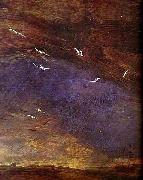 |
Pieter Bruegel the Elder -- Click Here
|
|
(Dutch pronunciation:c. 1525 - 9 September 1569) was a Flemish Renaissance painter and printmaker known for his landscapes and peasant scenes (Genre Painting). He is sometimes referred to as "Peasant Bruegel" to distinguish him from other members of the Brueghel dynasty, but is also the one generally meant when the context does not make clear which "Bruegel" is being referred to. From 1559 he dropped the 'h' from his name and started signing his paintings as Bruegel.
There are records that he was born in Breda, Netherlands, but it is uncertain whether the Dutch town of Breda or the Belgian town of Bree, called Breda in Latin, is meant. He was an apprentice of Pieter Coecke van Aelst, whose daughter Mayken he later married. He spent some time in France and Italy, and then went to Antwerp, where in 1551 he was accepted as a master in the painter's guild. He traveled to Italy soon after, and then returned to Antwerp before settling in Brussels permanently 10 years later. He received the nickname 'Peasant Bruegel' or 'Bruegel the Peasant' for his alleged practice of dressing up like a peasant in order to mingle at weddings and other celebrations, thereby gaining inspiration and authentic details for his genre paintings. He died in Brussels on 9 September 1569 and was buried in the Kapellekerk. He was the father of Pieter Brueghel the Younger and Jan Brueghel the Elder. Both became painters, but as they were very young children when their father died, it is believed neither received any training from him. |
|
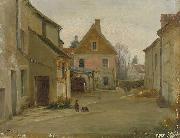 |
Pierre-edouard Frere -- Click Here
|
|
(1819 - 1886), French painter, studied under Hippolyte Delaroche, entered the e - ole des Beaux-Arts in 1836 and exhibited first at the Salon in 1843. The marked sentimental tendency of his art makes us wonder at John Ruskin's enthusiastic eulogy which finds in Frere's work the depth of William Wordsworth, the grace of Joshua Reynolds, and the holiness of Fra Angelico. What we can admire in his work is his accomplished craftsmanship and the intimacy and tender homeliness of his conception. Among his chief works are the two paintings, Going to School and Coming from School, The Little Glutton (his first exhibited picture) and L'Exercice (in the 19th century this work was in John Jacob Astor's collection). A journey to Egypt in 1860 resulted in a small series of Orientalist subjects, but the majority of Frere's paintings deal with the life of the kitchen, the workshop, the dwellings of the humble, and mainly with the pleasures and little troubles of the young, which the artist brings before us with humor and sympathy. He was one of the most popular painters of domestic genre in the middle of the 19th century.
|
|
 |
Pierre Pater The Elder -- Click Here
|
|
Picardy ca 1605-Paris 1676 |
|
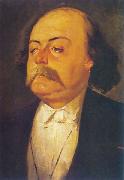 |
Pierre Francois Eugene Giraud -- Click Here
|
|
painted Gustave Flaubert vers in 1856 |
|
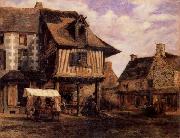 |
Pierre etienne theodore rousseau -- Click Here
|
|
Paris 1812-Barbizon 1867
French painter of the Barbizon school, was born in Paris, of a bourgeois family which included one or two artists.At first he received a business training, but soon displayed aptitude for painting. Although his father regretted the decision at first, he became reconciled to his son leaving business, and throughout the artist's career (for he survived his son) was a sympathizer with him in all his conflicts with the Paris Salon authorities. Theodore Rousseau shared the difficulties of the romantic painters of 1830 in securing for their pictures a place in the annual Paris exhibition. The whole influence of the classically trained artists was against them, and not until 1848 was Rousseau adequately presented to the public. He had exhibited one or two unimportant works in the Salon of 1831 and 1834, but in 1836 his great work "La descente des vaches" was rejected by the vote of the classic painters; and from then until after the revolution of 1848 he was persistently refused. He was not without champions in the press, and under the title of "le grand refus" he became known through the writings of Thor, the critic who afterwards resided in England and wrote under the name of Burger. During these years of artistic exile Rousseau produced some of his finest pictures: "The Chestnut Avenue", "The Marsh in the Landes" (now in the Louvre), "Hoar-Frost" (now in America); and in 1851, after the reorganization of the Salon in 1848, he exhibited his masterpiece, "The Edge of the Forest" (also in the Louvre), a picture similar in treatment to, but slightly varied in subject from, the composition called "A Glade in the Forest of Fontainebleau", in the Wallace Collection at Hertford House, London. Up to this period Rousseau had lived only occasionally at Barbizon, but in 1848 he took up his residence in the forest village, and spent most of his remaining days in the vicinity. He was now at the height of his artistic power, and was able to obtain fair sums for his pictures (but only about one-tenth of their value thirty years after his death), and his circle of admirers increased. He was still ignored by the authorities, for while Narcisse Virgilio Diaz was made Chevalier of the Legion of Honour in 1851, Rousseau was left undecorated at this time, but was nominated shortly afterwards. At the Exposition Universelle of 1853, where all Rousseau's rejected pictures of the previous twenty years were gathered together, his works were acknowledged to form one of the finest of the many splendid groups there exhibited. But during his lifetime Rousseau never really conquered French taste, and after an unsuccessful sale of his works by auction in 1861, |
|
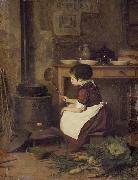 |
Pierre Edouard Frere -- Click Here
|
|
(1819-1886), French painter, studied under Hippolyte Delaroche, entered the cole des Beaux-Arts in 1836 and exhibited first at the Salon in 1843. The marked sentimental tendency of his art makes us wonder at John Ruskin's enthusiastic eulogy which finds in Frere's work the depth of William Wordsworth, the grace of Joshua Reynolds, and the holiness of Fra Angelico. What we can admire in his work is his accomplished craftsmanship and the intimacy and tender homeliness of his conception. Among his chief works are the two paintings, Going to School and Coming from School, The Little Glutton (his first exhibited picture) and L'Exercice (in the 19th century this work was in John Jacob Astor's collection). A journey to Egypt in 1860 resulted in a small series of Orientalist subjects, but the majority of Frere's paintings deal with the life of the kitchen, the workshop, the dwellings of the humble, and mainly with the pleasures and little troubles of the young, which the artist brings before us with humor and sympathy. He was one of the most popular painters of domestic genre in the middle of the 19th century. |
|
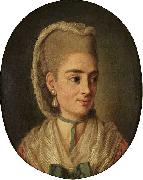 |
Per Krafft the Elder -- Click Here
|
|
(16 January 1724, Arboga - 7 November 1793, Stockholm) was a Swedish portraitist. He was the father of the artists Per Krafft the Younger and Wilhelmina Krafft.
|
|
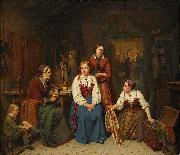 |
Per Eskilson -- Click Here
|
|
Sweden (1820 -1872 ) - Painter
|
|
|
|
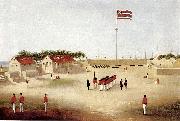 |
Paul Emmert -- Click Here
|
|
Paul Emmert (1826-1867) , who is also known as Paul Emert, was an artist born near Berne, Switzerland in 1826. By 1845, he had become an established artist in New York. He joined the gold rush to California in 1849. The following year he exhibited in Brooklyn a panorama of the gold mining activities before making his second trip to California late in 1850. While in California, he operated the Bear Hotel in Sacramento and exhibited the panorama in San Francisco and other communities. In 1853 he moved to Hawaii where he resided until his death in 1867 in Honolulu.
|
|
|
|
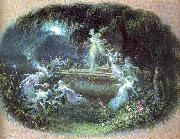 |
Parris, Edmund Thomas -- Click Here
|
|
English, 1793-1873 |
|
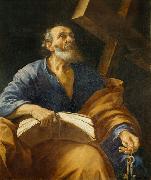 |
Paolo Emilio Besenzi -- Click Here
|
|
(1608-1656) was an Italian painter of the 17th century, born and active in Reggio. He trained with Francesco Albani. Friend and companion of Lionello Spada, he painted for the church of San Pietro. He was also known as sculptor and architect.
|
|
|
|
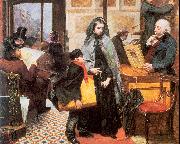 |
Osborn, Emily Mary -- Click Here
|
|
English, 1834-1893 |
|
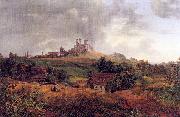 |
Oehme, Ernst Ferdinand -- Click Here
|
|
German, 1797-1855 |
|
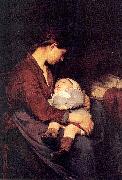 |
Nourse, Elizabeth -- Click Here
|
|
American Painter, 1860-1938 |
|
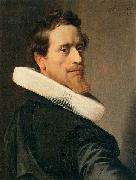 |
Nicolaes Eliaszoon Pickenoy -- Click Here
|
|
(10 January 1588 - 1653/1656) was a Dutch painter of Flemish origin. Pickenoy was possibly a pupil of Cornelis van der Voort and presumably Bartholomeus van der Helst was his own pupil.
He was the son of the Antwerp monumental mason Elias Claeszoon Pickenoy (1565-1640) and Heijltje Laurens s'Jonge (1562-1638), who emigrated to Amsterdam before Nicolaes Pickenoy was born. In 1621, living near the Oude Kerk, he married Levijntje Bouwens (1599-na 1656), an orphan of 21 years. They had ten children: Sara and Elias died young.
Pickenoy painted large Schuttersstukken, group portraits of the regents of the orphanage, and individual portraits of local or national celebrities like Nicolaes Tulp, Cornelis de Graeff, Maarten Harpertszoon Tromp and Jochem Hendrickszoon Swartenhont, Elisabeth Bas's husband. The earliest picture ascribed to the artist is "Dr. Sebastiaen Egbertz de Vrij's Osteological Presentation" of 1619, now in Amsterdam Historisch Museum. His heyday was ca. 1630-1637, a period marked by a high artistic level and numerous commissions from prominent patrons. After 1637 he painted little, save for a number of prestigiouseand lucrativeegroup portraits. Besides portraits, he also painted a small number of biblical subjects, one of which can be seen in the Museum Catharijneconvent. The Rijksmuseum Amsterdam and Amsterdams Historisch Museum holds many of his best works, not least the Schutterstukken or militia paintings.
In 1637 he bought from Adriaen Pauw the house on the corner of Sint Anthoniessluis and Jodenbreestraat, a fashionable area with many painters, art dealers, jewellers and so on. The house had previously been owned by his supposed master, Cornelis van der Voort, and later by Hendrick van Uylenburgh. During the years 1631-1634 the latter was collaborating with Rembrandt van Rijn, who painted numerous portraits for Van Uylenburgh's art business. Thus the house Pickenoy purchased had been a centre of Amsterdam portraiture for decades. In 1639 Rembrandt returned to the neighbourhood as he bought the house next to Pickenoys, the present day Rembrandthuis. Rembrandt could leave his house via an exit onto the Zwanenburgwal under the house of his neighbor Pickenoy. He brought out Night Watchepainted in his courtyarderolled up through the tunnel. Like Rembrandt, Pickenoy was not able to bring up the loan and so after eight years he sold the house.
The work of Pickenoy is difficult to distinguish from that of some of his contemporaries. Typical of Pickenoy are the fiercely invading light that makes the heads stand out sharply, the somewhat exaggerated gestures, the large greenish brown shadows and the odd-shaped eyes.
|
|
|
|
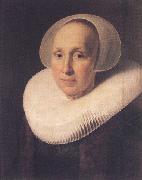 |
Nicolaes eliasz -- Click Here
|
|
Dutch Baroque Era Painter, ca.1588-1655 |
|
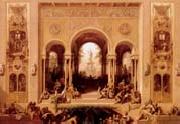 |
NEUREUTHER, Eugen -- Click Here
|
|
German painter b. 1806, Mnchen, d. 1882, Menchen,German lithographer, illustrator, decorative artist and painter. He was the son of the painter and printmaker Ludwig Neureuther (d 1832), and began his studies in Munich in 1823. His tutors included Peter von Cornelius, who enlisted him and several other young painters to help decorate the Glyptothek, and Wilhelm von Kobell. In 1830, fired with enthusiasm for the July Revolution in France, Neureuther went to Paris. He produced numerous studies from life (Munich, Staatl. Graph. Samml.), which are among his best works. From 1836-7 he was in Rome. From 1848 to 1856 he ran the Nymphenburg Porzellanmanufaktur, and for ten years from 1868 he taught decorative mural painting at the Munich Kunstgewerbeschule. Neureuther's principal importance lay in the field of book illustration. His reputation was established with the Vignettes for Goethe's Ballads and Romances (Randzeichnungen zu Goethes Balladen und Romanzen), published by J. G. Cotta in five booklets of 46 lithographic contour drawings in Munich, Stuttgart and Tebingen between 1829 and 1839. Goethe, to whom Cornelius had mentioned Neureuther, repeatedly spoke of these works in public, realizing their similarity to the prayer book of the Emperor Maximilian illustrated by Albrecht Derer, Lukas Cranach the elder, Hans Baldung, Albrecht Altdorfer and others. A new edition of this work, with lithographs by August Strixner (b 1820) had appeared in 1808. Neureuther later illustrated many other texts, but his approach became increasingly naturalistic and picturesque, and there was a notable decline in the artistic standard of the work. |
|
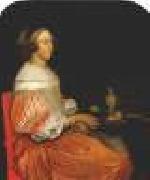 |
NEER, Eglon van der -- Click Here
|
|
Dutch Baroque Era Painter, ca.1634-1703
Son of Aert van der Neer. His birth date is based on Houbraken's statement that the artist was 70 years old when he died. He apparently studied first with his father and then with the genre and history painter Jacob van Loo. According to Houbraken, van der Neer was in France c. 1654, where he served as painter to the Counts of Dona, Dutch governors of the principality of Orange. He returned to Holland by 1659 and is recorded as a resident of Amsterdam at the time of his marriage to Maria van Wagensvelt in Rotterdam on 20 February 1659. |
|
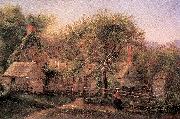 |
Mount, Evelina -- Click Here
|
|
American Painter, 1837-1920 |
|
 |
Morgan, Evelyn De -- Click Here
|
|
English, 1855-1919
Painter, wife of William De Morgan. She was a pupil of her uncle, the painter Roddam Spencer Stanhope. In 1873-5 she attended the Slade School of Art, London. While there, she was awarded a Slade scholarship entitling her to financial assistance for three years. The scholarship required that she draw in charcoal from the nude, but she eventually declined it because she did not wish to continue working in this technique, although she excelled in it. She was influenced by the work of the Pre-Raphaelite artists and became a follower of Burne-Jones. In 1877 she first exhibited at the Grosvenor Gallery, London, and continued to show there thereafter. From 1875 she spent several winters in Florence working and studying; some of her work is reminiscent of Botticelli, possibly because of her visits to Florence. She often depicted women in unfamiliar ways though in a manner more in tune with a female perspective. |
|
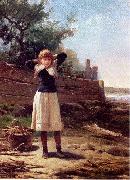 |
Moran, Edward -- Click Here
|
|
English-born American, 1829-1901
American painter of marine and historical subjects, b. England. He came to the United States with his family in 1844. In 1899 he completed a series of 13 paintings illustrating epochs in the maritime history of America from the landing of Leif Ericsson to the return of Admiral Dewey's fleet from the Philippines in 1899 (Pennsylvania Mus. of the Fine Arts, Philadelphia). His brother Thomas Moran, 1837?C1926, was an American landscape painter, illustrator, and etcher. He accompanied the exploring expeditions of Professor F. V. Hayden to the Yellowstone River (1871) and of Major J. W. Powell down the Colorado River (1873). Subsequently, he made the illustrations on wood for both expeditions' reports and the sketches from which he painted the two large canvases now in the Capitol at Washington, D.C., The Grand Canyon of the Yellowstone and Chasm of the Colorado. In 1884 he became a member of the National Academy of Design. As a painter Moran was strongly influenced by the art of Turner. Other examples of his painting are Bringing Home the Cattle (Buffalo, N.Y., Mus.); The Grand Canal, Venice; The Dream of the Orient; and Tower of Cortez, in Mexico, a watercolor. He also produced many etchings and magazine illustrations on wood. |
|
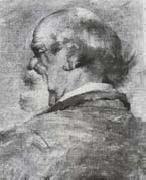 |
Miles Evergood -- Click Here
|
|
Australian Painter, 1871-1939, was an Australian artist. Evergood was born Myer Blashki in Melbourne, eleventh child of Philip Blashki, jeweller, and his wife Anna, nee Imergud. He studied for a while at the national gallery school under Bernard Hall between 1893 and 1895. He exhibited at the Victorian Artists Society, and the Royal Art Society, Sydney, before leaving for the United States in 1898. He worked principally in New York, with frequent visits to Europe, for about 30 years, establishing a good reputation as a painter. He changed his name to Miles Evergood while in the United States. Evergood returned to Australia about the end of 1931 and worked for a year in Queensland and became a member of the Royal Queensland Art Society. He then went to Sydney and Melbourne holding exhibitions of his work, and died of cancer in Melbourne on 3 January 1939. Evergood was a capable artist, who mostly painted landscapes in oil with affinities to the post impressionists. |
|
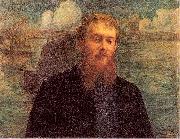 |
Menard, Emile-Rene -- Click Here
|
|
French, 1862-1930 |
|
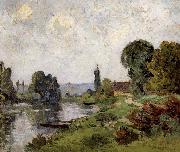 |
Maufra Maxime Emile Louis -- Click Here
|
|
Nantes 1861-Ponce-sur-Loir,Sarthe 1918
|
|
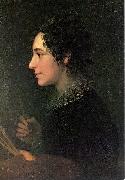 |
Marie Ellenrieder -- Click Here
|
|
Anna Marie Ellenrieder (March 20, 1791 - June 5, 1863, Konstanz) was a German painter.
She was born in Konstanz, Germany, the daughter of Konrad and Anna Maria Herrmann, and the granddaughter of Franz Ludwig Herrmann.
She studied under the miniature painter Joseph Einsle. Her portraits, similar in style to the ones of Angelica Kauffmann, made her the first woman to enter the Academy of Fine Arts Munich.
She spent the time between 1822 and 1824 in Rome, where she became a disciple of Friedrich Johann Overbeck. After this journey, she started painting religious topics such as "Christ Blessing Little Children" and "Mary and the Infant Jesus." Her two paintings "Der 12 jährige Jesus im Tempel / The 12 year old Jesus in the Temple", 1849 (oil on canvas, 203,2 x 139,7 cm) and "Hl Felicitas und ihre sieben Söhne / Holy Felicitas and her Seven Sons", 1847 (oil on canvas, 127 x 177,8 cm) were acquired by Queen Victoria who had been introduced to her work by the Prince Consort, who in turn had encountered the artist on his travels to Rome. They are now part of the Royal Collection in Osborne House.
She died in her home town of Konstanz. |
|
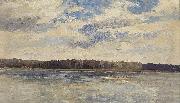 |
Marie Egner -- Click Here
|
|
painted On the Danube near Vienna in 1912 |
|
|
|
|
| | |
|
|
|
|